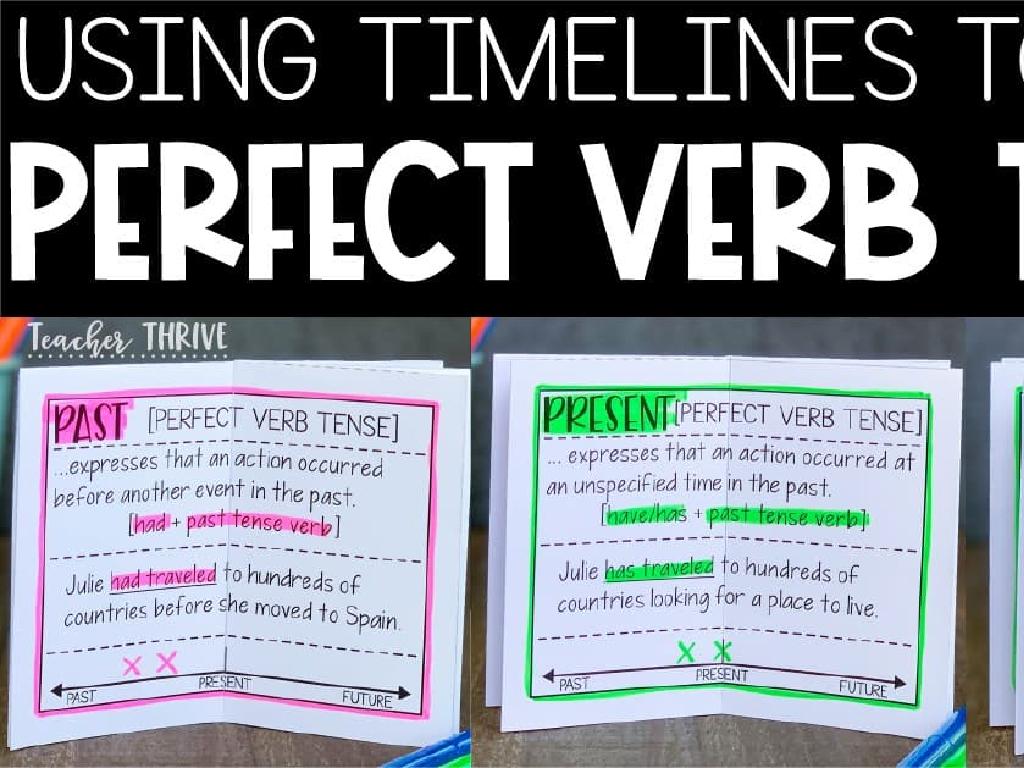Words With Un-, Dis-, In-, Im-, And Non-
Subject: Language arts
Grade: Sixth grade
Topic: Prefixes And Suffixes
Please LOG IN to download the presentation. Access is available to registered users only.
View More Content
Exploring Prefixes and Suffixes
– Building blocks of words
– Defining prefixes and suffixes
– Prefixes/suffixes are added to words to change their meaning
– The power of prefixes: un-, dis-, in-, im-, non-
– Examples: ‘unhappy’, ‘dislike’, ‘incomplete’, ‘impossible’, ‘nonstop’
– How prefixes/suffixes alter meaning
– ‘un-‘ can make a word mean ‘not’ or ‘the opposite of’
|
This slide introduces the concept of prefixes and suffixes, the essential components that modify the meanings of words. Prefixes like un-, dis-, in-, im-, and non- are added to the beginning of words to alter their meaning, often reversing them or negating them. For example, ‘un-‘ can change ‘happy’ to ‘unhappy,’ meaning ‘not happy.’ Suffixes, on the other hand, are added to the end of words and can indicate tense, part of speech, etc. This foundational knowledge will help students decode unfamiliar vocabulary and enhance their word comprehension skills. Encourage students to think of additional examples and consider how the meaning changes with different prefixes and suffixes.
Exploring Prefixes: Changing Word Meanings
– Define a prefix
– A prefix is a letter group added to a word start
– Prefixes alter root words
– They change the meaning of the root word
– Examples: un-, dis-, in-, im-, non-
– ‘un-‘ means not, as in unhappy; ‘dis-‘ means opposite, as in disagree
|
Introduce the concept of prefixes to students by defining what a prefix is and how it can alter the meaning of a root word. Provide examples of common prefixes such as ‘un-‘, ‘dis-‘, ‘in-‘, ‘im-‘, and ‘non-‘ and discuss the meanings they convey when attached to words. For instance, ‘un-‘ typically means ‘not,’ which changes ‘happy’ to ‘unhappy.’ Similarly, ‘dis-‘ often means ‘the opposite of,’ turning ‘agree’ into ‘disagree.’ Encourage students to think of additional examples and consider how the prefix transforms the original word. This understanding will help them decode unfamiliar vocabulary in the future.
The Power of ‘un-‘: Changing Meanings
– ‘un-‘ means ‘not’ or ‘opposite’
– Example: Happy Unhappy
– ‘Unhappy’ means not happy, showing how ‘un-‘ changes a word’s meaning.
– Discover more ‘un-‘ words
– We’ll search for words that start with ‘un-‘ and explore their meanings.
– Understand how ‘un-‘ alters words
– Grasp how adding ‘un-‘ to a word can flip its definition.
|
This slide introduces the prefix ‘un-‘ and its function to negate or reverse the meaning of the word it precedes. Start by explaining that ‘un-‘ can be attached to adjectives (like ‘happy’) to form their opposites (like ‘unhappy’). Encourage students to think of other words that can take ‘un-‘ and how it changes their meanings. This activity will help students understand how prefixes work and enhance their vocabulary. Have students brainstorm and list additional ‘un-‘ words as a class activity, discussing the new meanings each time. This will also reinforce the concept that language is flexible and creative.
Understanding the Prefix ‘dis-‘
– ‘dis-‘ means ‘not’ or ‘opposite of’
– Example: Appear Disappear
– ‘Disappear’ means to not be visible anymore
– Find words with ‘dis-‘
– Words like ‘dislike’ or ‘disagree’ show ‘dis-‘ in action
– Discuss the meaning changes
– How does ‘dis-‘ change the meaning of ‘agree’ to ‘disagree’?
|
The prefix ‘dis-‘ negates the original meaning of the word it precedes. It’s important for students to recognize how ‘dis-‘ transforms words, as it often turns them into their antonyms. For example, ‘appear’ means to become visible, while ‘disappear’ means to cease to be visible. Encourage students to brainstorm and share words that start with ‘dis-‘, such as ‘disrespect’, ‘disapprove’, or ‘discontinue’. Discuss how the prefix alters these words. This exercise will enhance their vocabulary and comprehension of how prefixes function in English.
Exploring ‘in-‘ and ‘im-‘ Prefixes
– ‘in-‘ and ‘im-‘ mean ‘not’ or ‘without’
– ‘im-‘ used before ‘p’ or ‘b’
– Example: Possible Impossible
– ‘Impossible’ means not possible
– Example: Perfect Imperfect
– ‘Imperfect’ means not perfect
|
This slide introduces the prefixes ‘in-‘ and ‘im-‘ which are commonly used in English to negate the meaning of a word. It’s crucial to highlight that ‘im-‘ is specifically used when the root word begins with ‘p’ or ‘b’. Provide students with examples to illustrate the concept. For ‘Possible’ becoming ‘Impossible’, it changes the meaning to not possible, indicating something that cannot happen. Similarly, ‘Perfect’ changes to ‘Imperfect’, which means not perfect, indicating something with flaws. Encourage students to think of other words that follow this rule and to understand how prefixes alter the meaning of the original terms.
Understanding the Prefix ‘non-‘
– ‘non-‘ means ‘not’ or ‘without’
– Used with nouns and adjectives
– Example: ‘Nonstop’
– ‘Nonstop’ means without any stops or breaks
– Enhances vocabulary usage
– Recognize how ‘non-‘ changes word meaning
|
The prefix ‘non-‘ is a simple yet powerful tool in the English language that students can use to expand their vocabulary. It negates the meaning of the base word it precedes. When teaching this concept, emphasize that ‘non-‘ can be attached to a wide range of nouns and adjectives to flip their meaning to the opposite, such as ‘non-toxic’ (not toxic) or ‘nonfiction’ (not fiction). Encourage students to think of other examples and consider how the addition of ‘non-‘ can change the meaning of words they already know. This understanding will help them decode unfamiliar words in the future.
Suffixes: Expanding Words
– Suffixes modify word endings
– They change words’ part of speech
– ‘Joy’ to ‘Joyful’: noun to adjective
– ‘Joyful’ shows emotion, unlike ‘joy’
– Practice with different suffixes
– Find more examples, like ‘care’ to ‘careful’
|
This slide introduces the concept of suffixes and how they can alter the meaning and grammatical function of a base word. Students should understand that suffixes are added to the end of words to expand their meaning and can often change the word’s part of speech, such as turning a noun into an adjective. Use ‘joy’ and ‘joyful’ as a clear example to illustrate this point. Encourage students to think of other examples and consider how the addition of a suffix can change the way we use a word in a sentence. Instruct them to practice by identifying base words and creating new words with different suffixes, noting the change in meaning and part of speech.
Class Activity: Crafting Words with Prefixes
– Learn about prefixes ‘un-‘, ‘dis-‘, ‘in-‘, ‘im-‘, ‘non-‘
– Pair up and choose root words
– Find words like ‘happy’, ‘cover’, ‘possible’
– Add prefixes to make new words
– For example, ‘unhappy’, ‘discover’, ‘impossible’
– Create a list of your new words
|
This activity is designed to help students understand how prefixes can alter the meaning of root words. Start by explaining each prefix and what it means when added to a word. Then, have students pair up and select root words to which they will add prefixes ‘un-‘, ‘dis-‘, ‘in-‘, ‘im-‘, and ‘non-‘. Encourage creativity and exploration of how the meaning changes with each prefix. For example, ‘happy’ becomes ‘unhappy’, which means not happy. After creating their list, each pair will share their new words with the class. This will help students learn from each other and reinforce their understanding of prefixes. As a teacher, be ready to provide guidance and ensure that the words created are appropriate and correctly use the prefixes.
Prefix Power: Review and Practice
– Recap of prefixes un-, dis-, in-, im-, non-
– Prefixes can negate or reverse a word s meaning
– Practice: Fill in the blanks with prefixes
– Use the correct prefix to complete sentences
– Discuss your answers with classmates
– Share and compare your answers in groups
– Understand how prefixes change word meanings
|
Begin with a quick review of the prefixes un-, dis-, in-, im-, and non-, emphasizing how they alter the meanings of the words they precede. Provide students with sentences that have missing prefixes and ask them to fill in the blanks using their understanding of each prefix. Encourage students to work in pairs or small groups to discuss their choices and the reasoning behind them. This activity will help reinforce their knowledge of prefixes and enhance their vocabulary. After the practice session, facilitate a class discussion where students can share their answers and learn from each other’s insights. The goal is to ensure that students can confidently use these prefixes to decode unfamiliar words and expand their vocabulary.
Homework: Exploring Prefixes
– Find words with specific prefixes
– Look for words with un-, dis-, in-, im-, non-
– Write sentences using new words
– Create your own sentences with these words
– Share your sentences in class
– Practice presenting to your family or pets
– Focus on un-, dis-, in-, im-, non-
|
This homework assignment encourages students to apply their knowledge of prefixes to discover new vocabulary. They should find five words that begin with the prefixes un-, dis-, in-, im-, or non-. After finding the words, students need to write original sentences that demonstrate the meaning of each word. This exercise will help them understand how prefixes alter the meaning of root words. In the next class, students will have the opportunity to share their sentences, which will reinforce their learning and improve their public speaking skills. Teachers should remind students to be creative and use resources like dictionaries or the internet to find their words.






